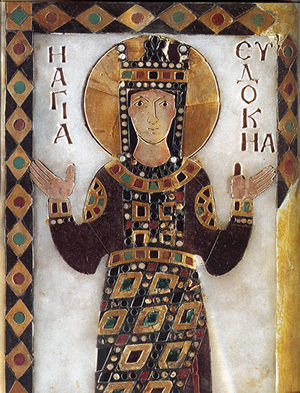Previous Translations of the Month
April 2024
The Lives of Saint Constantina: Introduction, Translations, and Commentaries. Edited by Marco Conti, Virginia Burrus, and Dennis Trout. Oxford University Press, 2021. ISBN 9780198854425 (hardcover)
 Sarcophagus associated with Saint Constantina, ca 340, Italian, Vatican City, Museo Pio-Clementino. Formerly in Rome, Santa Costanza (Source: Wikimedia Commons, Attribution-Share Alike 3.0 Unported license, Photo by Jean-Pol Grandmont)
Sarcophagus associated with Saint Constantina, ca 340, Italian, Vatican City, Museo Pio-Clementino. Formerly in Rome, Santa Costanza (Source: Wikimedia Commons, Attribution-Share Alike 3.0 Unported license, Photo by Jean-Pol Grandmont)
"Constantina, daughter of the fourth-century emperor Constantine who so famously converted to Christianity, deserves a place of her own in the history of Christianity. As both poet and church-builder, she was an early patron of the Roman cult of the virgin martyr Agnes and was buried ad sanctam in a sumptuously mosaicked mausoleum that still stands. What has been very nearly forgotten is that the twice-married Constantina also came to be viewed as a virgin saint in her own right, said to have been converted and healed of leprosy by Saint Agnes. This volume publishes for the first time critical editions and English translations of three Latin hagiographies dedicated to the empress, offering an introduction and commentaries to contextualize these virtually unknown works. The earliest and longest of them is the anonymous Life of Saint Constantina likely dating to the mid or late sixth century, reflecting a female monastic setting and featuring both a story of Pope Silvester's instruction of Constantina and a striking dialogue between Constantina and twelve virgins who offer speeches in praise of virginity as the summum bonum. A second, slightly later work, On the Feast of Saint Constantia (the misnaming of the saint reflecting common confusion), is a more streamlined account apparently tailored for liturgical use in early seventh-century Rome; this text is reworked and expanded by the twelfth-century Roman scholar Nicolaus Maniacoria in his Life of the Blessed Constantia, including a question-and-answer dialogue between Constantina and her two virginal charges Attica and Artemia. These works will be of great interest to students of late ancient and medieval saints' cults, hagiography, monasticism, and women's history."— [Reproduced from the publisher's website]
February 2024
The Translator of Desires: Poems. By Muhyiddin Ibn ʿArabi. Translated by Michael Sells. Princeton University Press, 2021. ISBN 9780691181349 (pbk) and 9780691212548 (online)
 Carpet with scrolling vines and blossoms, ca 1650, Northern India, Pakistan, Kashmir or Lahore. Metropolitan Museum, 14.40.725 (Source: Metropolitan Museum of Art, Open access)
Carpet with scrolling vines and blossoms, ca 1650, Northern India, Pakistan, Kashmir or Lahore. Metropolitan Museum, 14.40.725 (Source: Metropolitan Museum of Art, Open access)
"The Translator of Desires, a collection of sixty-one love poems, is the lyric masterwork of Muhyiddin Ibn 'Arabi (1165-1240 CE), one of the most influential writers of classical Arabic and Islamic civilization. In this authoritative volume, Michael Sells presents the first complete English translation of this work in more than a century, complete with an introduction, commentary, and a new facing-page critical text of the original Arabic. While grounded in an expert command of the Arabic, this verse translation renders the poems into a natural, contemporary English that captures the stunning beauty and power of Ibn 'Arabi's poems in such lines as “A veiled gazelle's / an amazing sight, / her henna hinting, / eyelids signalling // A pasture between / breastbone and spine / Marvel, a garden / among the flames!”
The introduction puts the poems in the context of the Arabic love poetry tradition, Ibn 'Arabi's life and times, his mystical thought, and his "romance" with Niẓām, the young woman whom he presents as the inspiration for the volume—a relationship that has long fascinated readers. Other features, following the main text, include detailed notes and commentaries on each poem, translations of Ibn 'Arabi's important prefaces to the poems, a discussion of the sources used for the Arabic text, and a glossary.
Bringing The Translator of Desires to life for contemporary English readers as never before, this promises to be the definitive volume of these fascinating and compelling poems for years to come."— [Reproduced from the publisher's website]
January 2024
Latin Love Elegy and the Dawn of the Ovidian Age: A Study of the "Versus Eporedienses" and the Latin Classics. By Marek Thue Kretschmer. Brepols Publishers, 2020. ISBN 9782503587035 (pbk) and 9782503587042 (online).
 "Le romant des Fables Ovide le Grant", ou les Métamorphoses d'Ovide moralisées en vers français par Chrestien Legouais de Sainte-More près Troyes, 1301-1325, French, Bibliothèque de l'Arsenal, Ms-5069 réserve, fol. 68r. (Source: Gallica, Public domain)
"Le romant des Fables Ovide le Grant", ou les Métamorphoses d'Ovide moralisées en vers français par Chrestien Legouais de Sainte-More près Troyes, 1301-1325, French, Bibliothèque de l'Arsenal, Ms-5069 réserve, fol. 68r. (Source: Gallica, Public domain)
"The Versus Eporedienses (Verses from Ivrea), written around the year 1080 and attributed to a certain Wido, is a highly fascinating elegiac love poem celebrating worldly pleasures in an age usually associated with contemptus mundi. One of the poem's intriguing features, its extensive use of the Latin classics, especially of Ovid, makes it a precursor of the poetry of the so-called twelfth-century renaissance. In this first book-length study of the poem, the author provides a historical contextualisation, an edition and translation, a verse-by-verse commentary, a detailed analysis of the classical sources and a discussion of its similarities with contemporary and later medieval poetry."— [Reproduced from the publisher's website]
 Indexers select a translation each month that is significant in the ideas it presents. This gives users an opportunity to see a range of newly translated medieval works of importance for women’s and gender studies. It also will build an archive of references to translations that will be useful as classroom readings.
Indexers select a translation each month that is significant in the ideas it presents. This gives users an opportunity to see a range of newly translated medieval works of importance for women’s and gender studies. It also will build an archive of references to translations that will be useful as classroom readings.
Depending upon the content, an entire work may be indexed as a single title like the vita of a saint or the collected cartularies of a countess. But in many cases the translation deals only in part with issues involving women and gender. In those instances, indexing goes to a deeper level, identifying and describing specific sections within a text. For example, there are 93 records for pertinent sections in the Siete Partidas.
To see more translations, go to the Advanced Search Page and put “Translation” in the Article Type box. Add specific terms to Keyword, Century or Geographical Area as needed.
There are currently over 3000 records for translations in Feminae. There are also over 500 records for editions in original languages.
Feminae welcomes unpublished translations and editions that authors may wish to make available.
Return to Current Translation of the Month
Top of Page